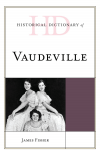Zusammenfassung
Vaudeville, as it is commonly known today, began as a response to scandalous variety performances appealing mostly to adult, male patrons. When former minstrel performer and balladeer Tony Pastor opened the Fourteenth Street Theatre in New York in 1881, he was guided by a mission to provide family-friendly variety shows in hopes of drawing in that portion of the audience – women and children – otherwise inherently excluded from variety bills prior to 1881. There he perfected a framework for family-oriented amusements of the highest obtainable quality and style.
Historical Dictionary of Vaudeville contains a chronology, an introduction, an extensive bibliography, and the dictionary section has more than 1,000 cross-referenced entries on performing artists, managers and agents, theatre facilities, and the terminology central to the history of vaudeville. This book is an excellent resource for students, researchers, and anyone wanting to know more about vaudeville.
Schlagworte
Satire Radio dance actors Gender Roles Musical Theatre Minstrel shows Race/ethnicity Farce BurlesqueKeywords
music United States- Kapitel Ausklappen | EinklappenSeiten
- i–xxiv Preface i–xxiv
- 1–12 Introduction 1–12
- 13–636 THE DICTIONARY 13–636
- 637–664 Bibliography 637–664
- 665–666 About the Author 665–666

